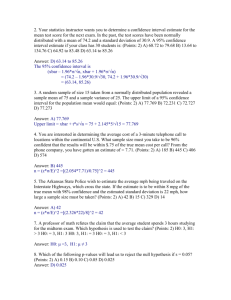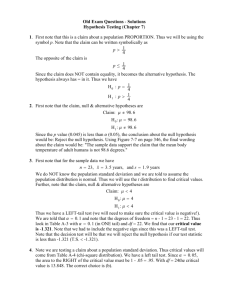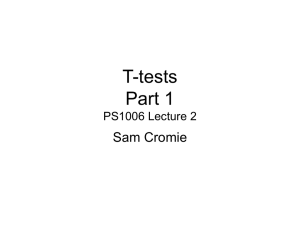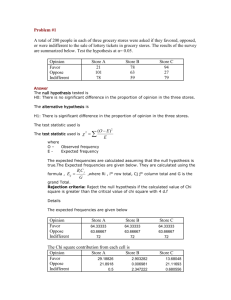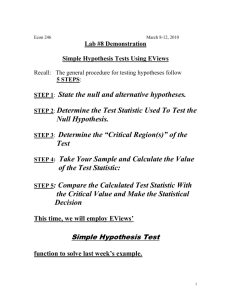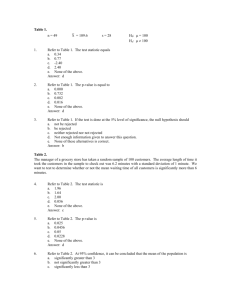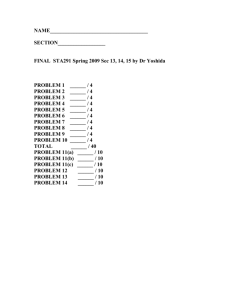3. An aerospace parts factory has two separate production lines
advertisement
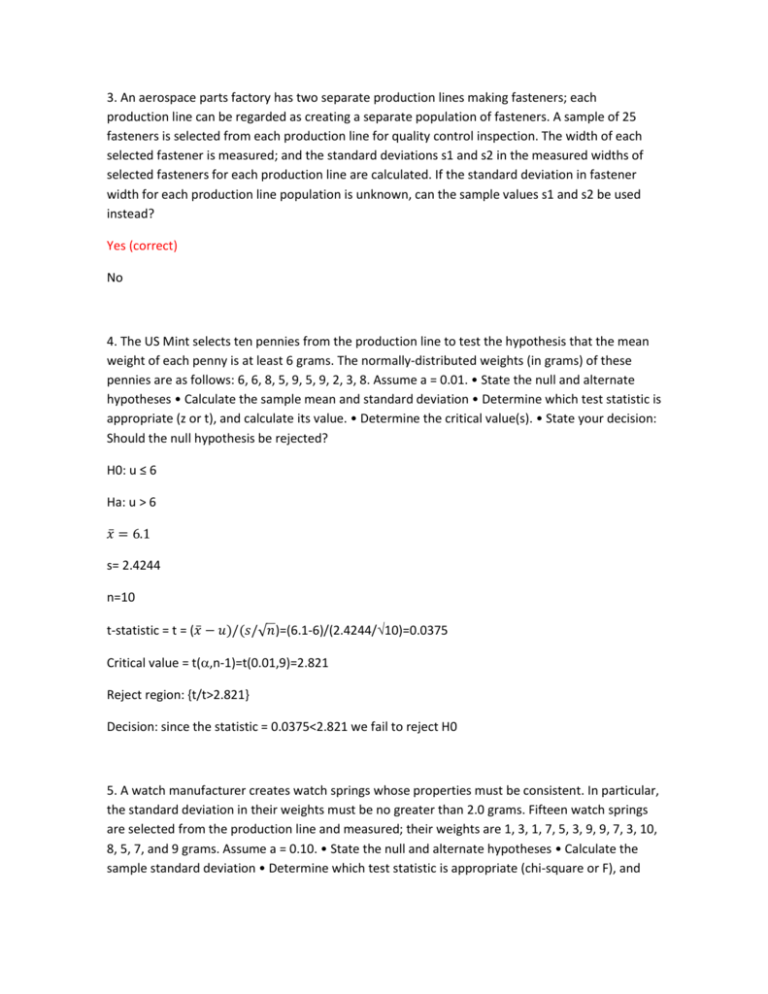
3. An aerospace parts factory has two separate production lines making fasteners; each
production line can be regarded as creating a separate population of fasteners. A sample of 25
fasteners is selected from each production line for quality control inspection. The width of each
selected fastener is measured; and the standard deviations s1 and s2 in the measured widths of
selected fasteners for each production line are calculated. If the standard deviation in fastener
width for each production line population is unknown, can the sample values s1 and s2 be used
instead?
Yes (correct)
No
4. The US Mint selects ten pennies from the production line to test the hypothesis that the mean
weight of each penny is at least 6 grams. The normally-distributed weights (in grams) of these
pennies are as follows: 6, 6, 8, 5, 9, 5, 9, 2, 3, 8. Assume a = 0.01. • State the null and alternate
hypotheses • Calculate the sample mean and standard deviation • Determine which test statistic is
appropriate (z or t), and calculate its value. • Determine the critical value(s). • State your decision:
Should the null hypothesis be rejected?
H0: u ≤ 6
Ha: u > 6
𝑥̅ = 6.1
s= 2.4244
n=10
t-statistic = t = (𝑥̅ − 𝑢)/(𝑠/√𝑛)=(6.1-6)/(2.4244/10)=0.0375
Critical value = t(,n-1)=t(0.01,9)=2.821
Reject region: {t/t>2.821}
Decision: since the statistic = 0.0375<2.821 we fail to reject H0
5. A watch manufacturer creates watch springs whose properties must be consistent. In particular,
the standard deviation in their weights must be no greater than 2.0 grams. Fifteen watch springs
are selected from the production line and measured; their weights are 1, 3, 1, 7, 5, 3, 9, 9, 7, 3, 10,
8, 5, 7, and 9 grams. Assume a = 0.10. • State the null and alternate hypotheses • Calculate the
sample standard deviation • Determine which test statistic is appropriate (chi-square or F), and
calculate its value. • Determine the critical value(s). • State your decision: Should the null
hypothesis be rejected?
H0: ≤2
Ha: >2
s = 3.028
n=15
Chi-square stastistic: =(n-1)s/
Critical value: n-1)=14)=21.064
Reject region: {
Decision: Since statistic is 32.091>21.064 we reject H0
(null hypothesis should be rejected)
6. A telephone survey gives 670 consumers two choices: Do they prefer Coke or Pepsi? Exactly 158
of those surveyed state that they prefer Coke. Assuming that a = 0.10, test the hypothesis that the
proportion of the population that prefers Coke is 50%. • State the null and alternate hypotheses •
Calculate the sample proportion • Calculate the value of the test statistic. • Determine the critical
value(s). • State your decision: Should the null hypothesis be rejected?
H0:p=0.5
Ha:p≠0.5
sample proportion=𝑝̂ =158/670=0.2358
Statistic: z-statistic =(𝑝̂ -p)/√(p*(1-p)/n) = (0.2358-0.5)/√(0.5*0.5/670)=-13.68
Critical value is z(0.05)=1.645
Reject region is : {z/z<-1.645 or z>1.645}
Since z-statistic =-13.68<-1.645 we reject H0
Yes, H0 should be rejected
7. Two groups of ten sprinters run 100 meters. The times required by sprinters in the first group
are as follows: 13.4 10.4 14.9 10.1 12.5 13.8 13.7 11.1 11.0 10.9 The times required by sprinters in
the second group are as follows: 12.1 15.1 12.1 11.4 16.7 18.1 16.3 10.1 18.1 16.9 Assuming that a
= 0.10, test the hypothesis that the means of the two populations are equal. • State the null and
alternate hypotheses • Calculate the mean and standard deviation for each group • Calculate the
value of the test statistic. • Determine the critical value(s). • State your decision: Should the null
hypothesis be rejected?
Mean of group 1 =𝑥̅1 = 11.164
Mean of group 2 = 𝑥̅2 = 13.536
Standard deviation of group 1 = s1 = 3.732
Standard deviation of group 2 = s2 = 4.761
H0 = u1=u2
Ha: u1≠u2
=0.05
n1=n2=10
(𝑛1−1)𝑠12 +(𝑛2−1)𝑠22
sp = √
𝑛1+𝑛2−2
t-statistic =
𝑥̅1 −𝑥̅2
1 1
𝑠𝑝 √ +
10 10
=√
9∗3.7322 +9∗4.7612
=4.278
18
11.164−13.536
=
4.278√1/5
= -1.24
Critical values are: ±t(/2,n1+n2-2)=±t(0.05,18)=±1.734
Reject region: {t/t<-1.734 or t>1.734}
Decision: Since t-statistic =-1.24[-1.734,1.734] we don´t reject H0


